Abstract
OBJECTIVE: This study examined whether incident cases of pertussis cluster in urban census tracts and identified community characteristics that predict high-incidence areas. METHODS: An ecological study design was used. The study population included all persons diagnosed with pertussis from January 1, 1986, through December 31, 1994. Maps of rates were constructed via a geographic information system and clustering was statistically confirmed. Associations between pertussis rates and community characteristics were tested. RESULTS: Mapping and statistical analysis revealed spatial clustering of pertussis. Higher age-adjusted rates of pertussis infection were associated with higher proportions of residents below poverty level. CONCLUSIONS: In urban areas pertussis infection clusters in areas of poverty.
Full text
PDF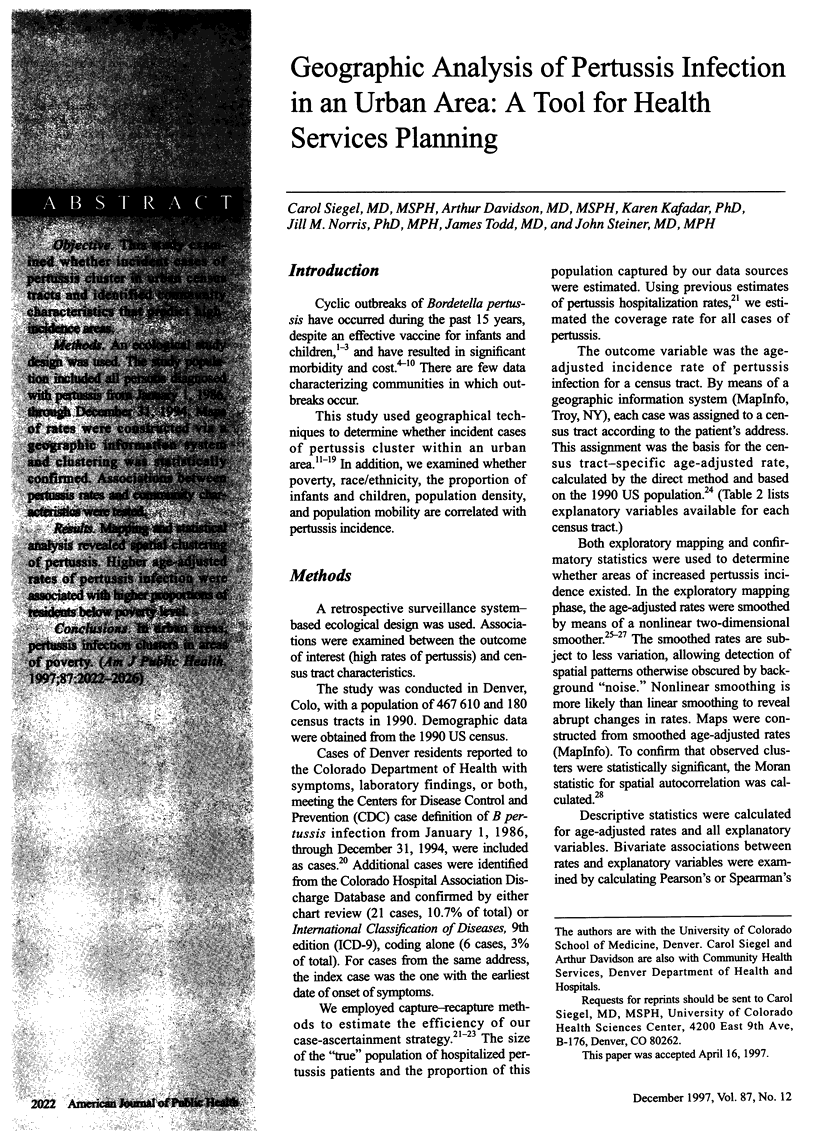
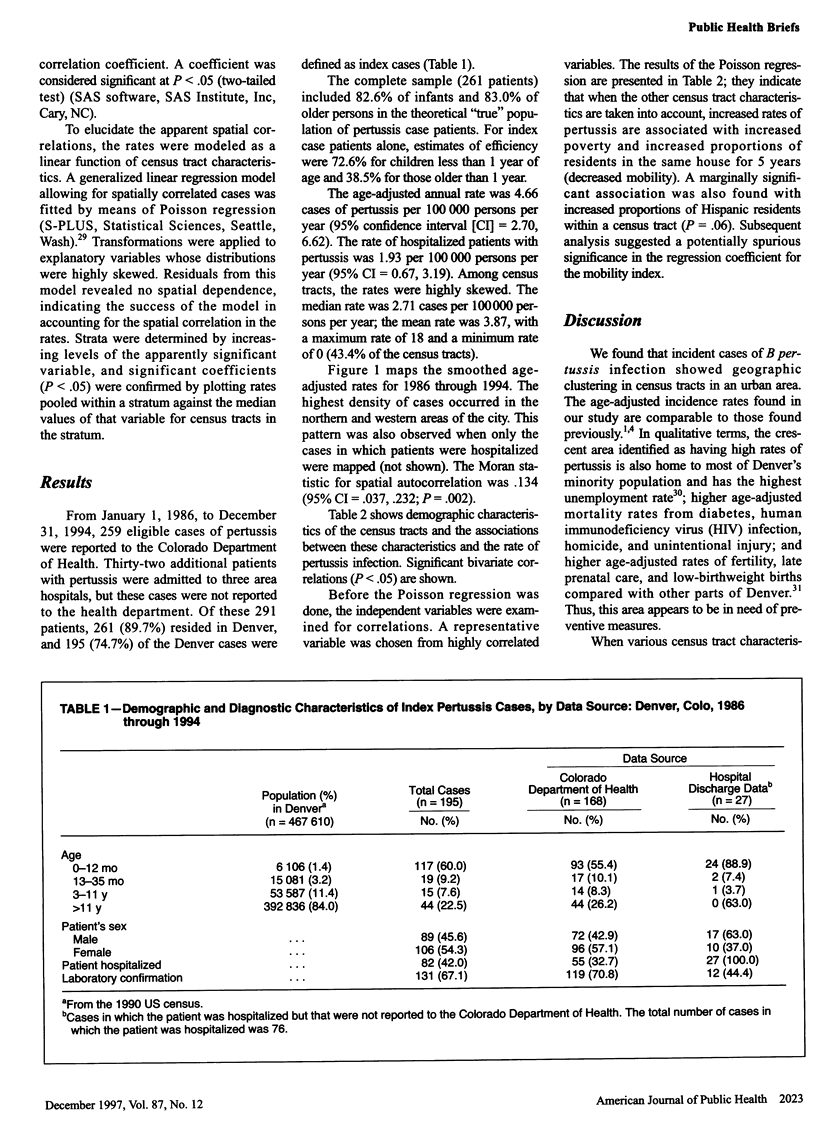
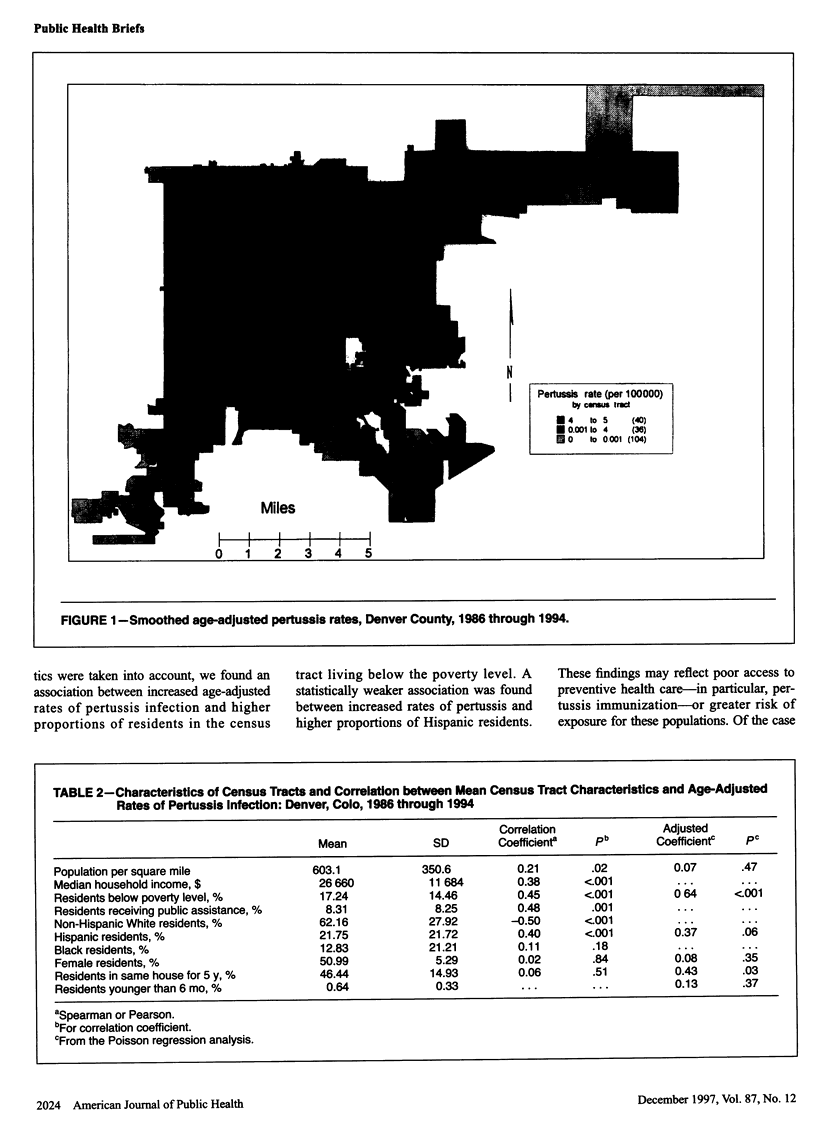
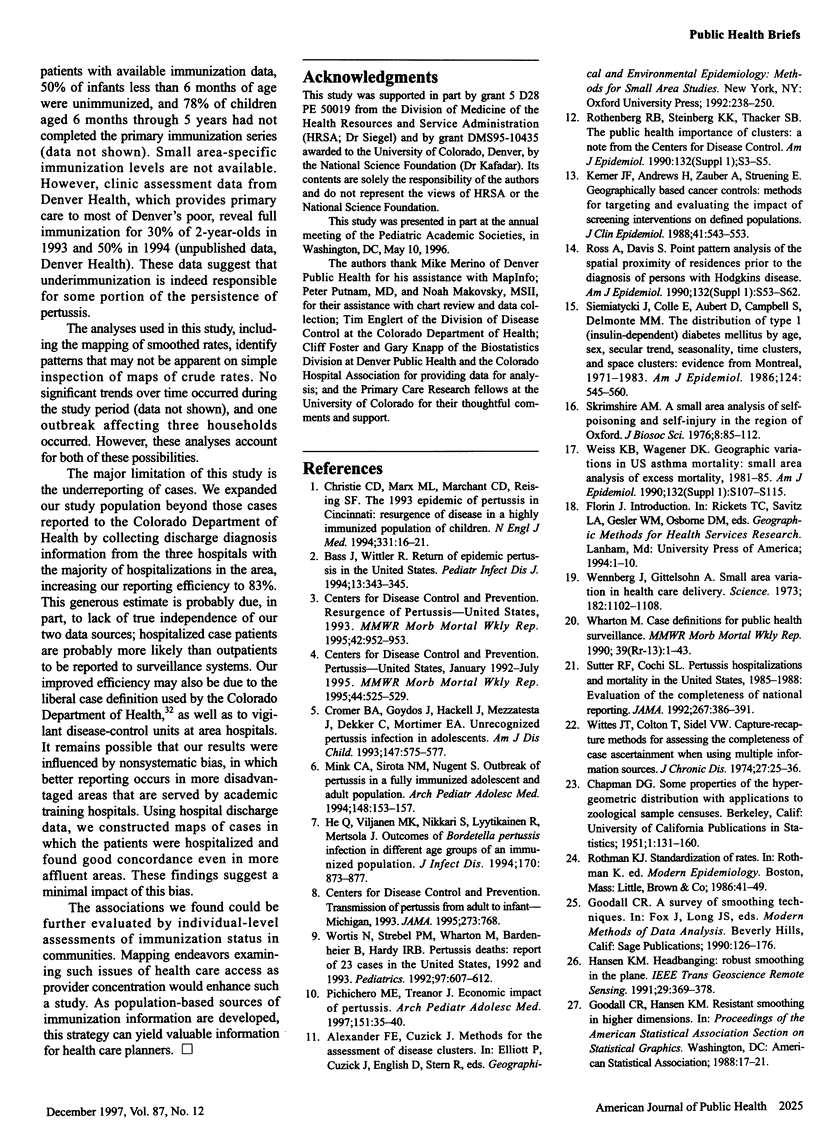
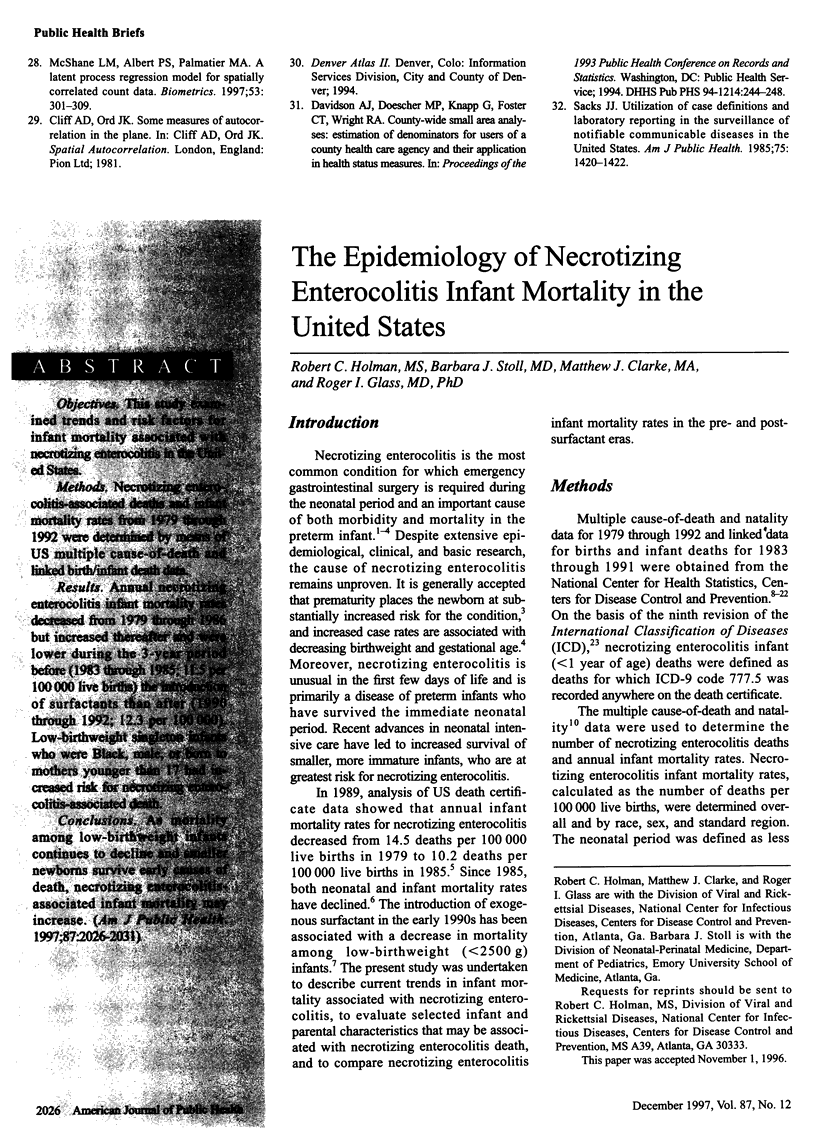
Selected References
These references are in PubMed. This may not be the complete list of references from this article.
- Bass J. W., Wittler R. R. Return of epidemic pertussis in the United States. Pediatr Infect Dis J. 1994 May;13(5):343–345. doi: 10.1097/00006454-199405000-00002. [DOI] [PubMed] [Google Scholar]
- Centers for Disease Control (CDC) Repeat injuries in an inner city population--Philadelphia, 1987-1988. MMWR Morb Mortal Wkly Rep. 1990 Jan 12;39(1):1–3. [PubMed] [Google Scholar]
- Christie C. D., Marx M. L., Marchant C. D., Reising S. F. The 1993 epidemic of pertussis in Cincinnati. Resurgence of disease in a highly immunized population of children. N Engl J Med. 1994 Jul 7;331(1):16–21. doi: 10.1056/NEJM199407073310104. [DOI] [PubMed] [Google Scholar]
- Cromer B. A., Goydos J., Hackell J., Mezzatesta J., Dekker C., Mortimer E. A. Unrecognized pertussis infection in adolescents. Am J Dis Child. 1993 May;147(5):575–577. doi: 10.1001/archpedi.1993.02160290081031. [DOI] [PubMed] [Google Scholar]
- He Q., Viljanen M. K., Nikkari S., Lyytikäinen R., Mertsola J. Outcomes of Bordetella pertussis infection in different age groups of an immunized population. J Infect Dis. 1994 Oct;170(4):873–877. doi: 10.1093/infdis/170.4.873. [DOI] [PubMed] [Google Scholar]
- Kerner J. F., Andrews H., Zauber A., Struening E. Geographically-based cancer control: methods for targeting and evaluating the impact of screening interventions on defined populations. J Clin Epidemiol. 1988;41(6):543–553. doi: 10.1016/0895-4356(88)90058-3. [DOI] [PubMed] [Google Scholar]
- Mink C. A., Sirota N. M., Nugent S. Outbreak of pertussis in a fully immunized adolescent and adult population. Arch Pediatr Adolesc Med. 1994 Feb;148(2):153–157. doi: 10.1001/archpedi.1994.02170020039006. [DOI] [PubMed] [Google Scholar]
- Pichichero M. E., Treanor J. Economic impact of pertussis. Arch Pediatr Adolesc Med. 1997 Jan;151(1):35–40. doi: 10.1001/archpedi.1997.02170380039006. [DOI] [PubMed] [Google Scholar]
- Ross A., Davis S. Point pattern analysis of the spatial proximity of residences prior to diagnosis of persons with Hodgkin's disease. Am J Epidemiol. 1990 Jul;132(1 Suppl):S53–S62. doi: 10.1093/oxfordjournals.aje.a115789. [DOI] [PubMed] [Google Scholar]
- Rothenberg R. B., Steinberg K. K., Thacker S. B. The public health importance of clusters: a note from the Centers for Disease Control. Am J Epidemiol. 1990 Jul;132(1 Suppl):S3–S5. doi: 10.1093/oxfordjournals.aje.a115785. [DOI] [PubMed] [Google Scholar]
- Sacks J. J. Utilization of case definitions and laboratory reporting in the surveillance of notifiable communicable diseases in the United States. Am J Public Health. 1985 Dec;75(12):1420–1422. doi: 10.2105/ajph.75.12.1420. [DOI] [PMC free article] [PubMed] [Google Scholar]
- Skrimshire A. M. A small area analysis of self-poisoning and self-injury in the region of Oxford. J Biosoc Sci. 1976 Apr;8(2):85–112. doi: 10.1017/s0021932000010531. [DOI] [PubMed] [Google Scholar]
- Sutter R. W., Cochi S. L. Pertussis hospitalizations and mortality in the United States, 1985-1988. Evaluation of the completeness of national reporting. JAMA. 1992 Jan 15;267(3):386–391. [PubMed] [Google Scholar]
- Weiss K. B., Wagener D. K. Geographic variations in US asthma mortality: small-area analyses of excess mortality, 1981-1985. Am J Epidemiol. 1990 Jul;132(1 Suppl):S107–S115. doi: 10.1093/oxfordjournals.aje.a115771. [DOI] [PubMed] [Google Scholar]
- Wennberg J., Gittelsohn Small area variations in health care delivery. Science. 1973 Dec 14;182(4117):1102–1108. doi: 10.1126/science.182.4117.1102. [DOI] [PubMed] [Google Scholar]
- Wittes J. T., Colton T., Sidel V. W. Capture-recapture methods for assessing the completeness of case ascertainment when using multiple information sources. J Chronic Dis. 1974 Feb;27(1):25–36. doi: 10.1016/0021-9681(74)90005-8. [DOI] [PubMed] [Google Scholar]
- Wortis N., Strebel P. M., Wharton M., Bardenheier B., Hardy I. R. Pertussis deaths: report of 23 cases in the United States, 1992 and 1993. Pediatrics. 1996 May;97(5):607–612. [PubMed] [Google Scholar]


